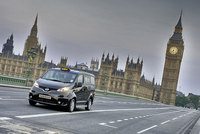Nissan's New London Taxi
By Henny Hemmes
Senior European Editor
The Auto Channel
AMSTERDAM, August 6, 2012. When you visit London, you cannot
overlook the London Taxi, or even have a ride in the black cab that was
based on the 1948 Austin FX3, built by Carbodies of Coventry, and from 1958
was replaced by the FX4. In the early eighties, Carbodies bought the
production rights from Austin, but had little money left for the
development of a new model and therefore stuck to new drive trains.

|
Most popular was the Nissan TD27 diesel engine, which was offered in
1989 in the Fairway model. Because of the easy access, also for wheel
chairs, it has been the favorite of the cabbies to this very day
In the meantime the TX1 with its retro design, and its later
successors, the TXII and TX4, replaced the iconic cab, while new
regulations, restricting the use of taxis over 15 years old, will result in
de disappearance of the and in the next few month the cab from the London
roads.
Nissan has now presented its view on an innovative new London Taxi,
which uses the NV200 design and packaging. It easily takes five passengers,
who have the best possible view through the large side windows. They also
have easy access thanks to the twin sliding doors that are an advantage
over the more traditional competitors. By extending the aperture of
the left-hand door in width and height, it also meets the requirements of
wheelchair users. At the rear the NV200 Taxi has twin leading doors that
split 70/30 and give access tot a large luggage area which can be enlarges
by sliding (part of) the rear three-seat units forwards.
The Nissan Cab is small enough to navigate through the narrow
streets and in order to improve visibility in urban traffic, the NV200
London Taxi’s indicators have been moved into the lower half of the
bumper, further towards the outer edge of the car. They are integrated with
LED daytime running lights.
The roof sign has been especially been developed and has been
approved by Transport for London.
The London Taxi project is the third after the successful ones for
New York City and Tokyo.. There also is an electric e-NV200 in the
planning.




